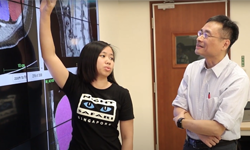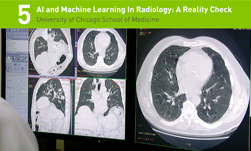‘Meet the Researcher’ is a series in which we spotlight different researchers in academia who are using GPUs to accelerate their work.
This week we spotlight Weichung Wang, Professor at the Institute of Applied Mathematical Sciences at the National Taiwan University.
Wang is a recipient of the Nian-Chih Award and has also received the Outstanding Young Scholar Project Award from the Ministry of Science and Technology in Taiwan. He serves as an associate editor of the SIAM Journal on Mathematics of Data Science and a manager editor of Annals of Mathematical Sciences and Applications. Wang’s MeDA Lab focuses on AI for medical image and data analytics.
NVIDIA: Tell us about your research?
Wang: My research interests include medical image/data analytics and high-performance scientific computing. By collaborating with medical practitioners or domain researchers, we develop efficient learning models, algorithms, and software workflows for better medical or scientific data analytical results in a shorter time.
NVIDIA: What motivated you to pursue this focus area?
Wang: I love to develop novel computational methods and apply the latest computing technologies to real-world scenarios. I also enjoy working with professionals across disciplines to provide thorough clinical solutions for users’ dilemmas in real life.
NVIDIA: Talk to us about your most recent project?
Wang: My team, MeDA Lab, and other collaborators are building a medical data analytics platform for better healthcare outcomes. This platform consists of a high-performance artificial intelligence engine and innovative augmented intelligence workflows. The AI engine enables us to accurately, efficiently, and robustly extract insightful information from a large volume of medical images and clinical datasets. The intelligent workflows assist physicians in reducing their loading, increasing diagnosis and prognosis accuracies, and making better treatment decisions in the daily clinical pathways.
We also aim at tackling some challenges in matrix computations for large-scale numerical simulation and big data analytics. The central themes are two-fold: (i) highly parallel and scalable eigenvalue solvers for numerical simulations such as three-dimensional photonic crystals and (ii) novel and efficient randomized type singular value decomposition for large-scale data analysis and machine learning.
NVIDIA: Tell us about your approach for addressing this challenge?
Wang: We develop AI-assisted clinical workflows with solid scientific evidence. Our approach to tackling this challenge involves interdisciplinary knowledge and technologies of artificial intelligence, medicine, high-performance computing, mathematics, and statistics. In high-performance scientific computing, our research usually involves application domain knowledge, algorithm development with mathematical or statistical analysis, and the latest computer architectures.
NVIDIA: What is the (expected) impact of your work on the field/community/world?
Wang: I am keen to help doctors to help people. By translating the AI technologies and intelligent workflows, my team’s goal is to improve physicians’ therapeutic decision process with niches in large-scale quantitative based computer aided diagnosis, decision-making, and disease prevention. I also hope our computational methods and tools may contribute to scientists’ innovations.
NVIDIA: How have you used our SDKs either in your current or previous research?
Wang: We use NVIDIA Clara to accelerate our research and deployment in medical AI. NVIDIA’s GPU allows us to perform large-scale scientific computing tasks efficiently.
NVIDIA: How has it impacted your work?
Wang: NVIDIA Clara accelerated our R&D process to get promising results in adaptive tumor segmentation, accurate pancreatic cancer classifications, personalized radiotherapy outcome predictions, and other medical AI models. NVIDIA Clara also made it easy for us to deploy the models in various settings. Therefore, we could perform federated learning over multiple cohorts and test our models on a national-wide database in Taiwan and even cross-country data sets. These results also led to publications and presentations in, e.g., The Lancet Digital Health and RSNA.
As another example, we had laid out the theoretical foundations of fast algorithms for Maxwell’s equations in the 3D photonic crystals and complex media numerical simulations. By integrating the mathematical insights and the power of the NVIDIA GPU, we successfully solved the eigenvalue problems as large as 6.29 million within 1 minute. To our best knowledge, such efficiency is far beyond all other methods reported in the literature.
NVIDIA: What’s next for your research?
Wang: I will continue the research paths in medical data-driven modelings with an emphasis on explainability and generalization. Furthermore, I am very interested in multi-modality and multi-scale analysis that considers time series data, lab test results, medical record texts, CT//MR/X-ray/pathology images, and genomics data simultaneously. I also hope our progress in research can facilitate medical AI education and landing.
NVIDIA: Any advice for new researchers?
Wang: Think and act, find your passions and strengths, keep learning new things, form collaboration teams, and make positive impacts effectively and efficiently.










